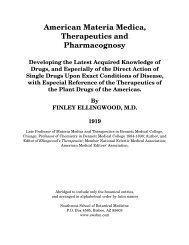SCARLET FEVER. Synonyms.—Scarlatina; Scarlet Rash. Definition ...
SCARLET FEVER. Synonyms.—Scarlatina; Scarlet Rash. Definition ...
SCARLET FEVER. Synonyms.—Scarlatina; Scarlet Rash. Definition ...
You also want an ePaper? Increase the reach of your titles
YUMPU automatically turns print PDFs into web optimized ePapers that Google loves.
acillus of Pfeiffer the causal agent.<br />
The method of entrance into the system is most likely by way of the<br />
respiratory apparatus, and the rapidity with which it travels and the<br />
great number attacked, irrespective of contact with each other, warrants<br />
this position.<br />
The scourge usually lasts from four to seven weeks. One attack does not<br />
render a person immune, and a second or third attack is common. The<br />
exhaustion that attends the disease renders the system susceptible to<br />
the influence of any and every toxin, and the sequelae of grip are<br />
legion.<br />
Pathology.—There are no characteristic anatomical lesions in a case of<br />
uncomplicated influenza. Where the disease has continued for some<br />
time, the mucous membrane of the air-passages as the disease<br />
progresses this becomes more profuse, is removed with less effort, the<br />
cough is easier, and the paroxysms occur at longer intervals. With the<br />
increased secretion of the mucus, the fever subsides, all the symptoms<br />
are mitigated, and the patient enters the convalescent stage from the<br />
fifth to the eighth day.<br />
In more severe cases a severe catarrhal bronchitis develops, with the<br />
usual attendant symptoms.<br />
One of the most frequent and severe complications of this type is<br />
pneumonia. The cough is short and hacking, the respiration labored and<br />
oppressed, and the patient presents an anxious appearance. If the<br />
pleura be also involved, a sharp lancinating pain accompanies the<br />
cough. The sputum assumes the characteristic rusty form, the crepitant<br />
and subcrepitant rales develop, there is dullness on percussion, and the<br />
dusky hue of the face speaks of imperfect aeration of the blood, and the<br />
patient has to be propped up in bed to assist the inspiratory muscles in<br />
filling the lungs. The symptoms are so pronounced that the case can not<br />
be mistaken.<br />
Heart-failure may occur in this type, though very rare, unless<br />
depressants, like the coal-tar products, have been used.<br />
Gastro-Intestinal.—In some the stomach and bowels appear to receive<br />
the force of the infection, there being nausea and vomiting, together<br />
with diarrhea. This type was noticed quite frequently in 1891. The<br />
The Eclectic Practice of Medicine - PART I - Infectious Diseases - Page 165

















